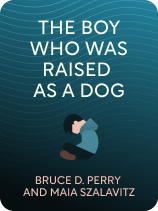

This article is an excerpt from the Shortform book guide to "The Boy Who Was Raised as a Dog" by Bruce D. Perry and Maia Szalavitz. Shortform has the world's best summaries and analyses of books you should be reading.
Like this article? Sign up for a free trial here.
What are some common responses to trauma? What can we learn from a deep dive into the effects of childhood trauma?
Responses to trauma vary depending on the associations you make surrounding the traumatic experience. By looking at an example of this, we can see how trauma impacts behaviors.
Read on to learn about how the brain forms associations with trauma via this case study.
Traumatic Associations: Tina’s Case
Understanding responses to trauma starts with understanding how the brain remembers things. The brain stores information in the form of memories and associations. Associations, like those between caregiving and the brain’s reward centers, occur when two neural patterns are activated at the same time again and again, eventually forming a new set of connections between areas of the brain. These connections then help us navigate future experiences that activate the same brain areas. Because these connections become stronger with each use, the connections we form from early experiences—and therefore have used more—are more difficult to change than the ones we acquire later.
To illustrate the role of associations in trauma, we will look the case of a young girl named Tina. At the age of seven, she was engaging in sexually inappropriate behaviors with peers and acting out in aggressive ways. She also behaved impulsively and had trouble paying attention in school. Tina’s mother explained that Tina had been sexually abused by a neighbor’s teenage son over the course of two years.
The associations formed in Tina’s brain from this experience caused an automatic stress response when she was around men, and the memory template she had developed based on the traumatic experiences taught her to try to appease them (and thus reduce the threat they posed) with sex. This association is what led her to behave inappropriately even with men who had never preyed on her. Additionally, the constant engagement of her stress response system led her to be on high alert for threats at all times, making it difficult for her to focus on schoolwork and control her impulses.
| Implicit vs. Explicit Associations Mental associations can be either explicit or implicit. Explicit associations are conscious, meaning you’re aware of them, but implicit associations are unconscious, so they operate beyond your conscious awareness. For example, if you were asked if you think dogs make good pets, you might reflect on the explicit association of seeing a child delightedly playing with their pet poodle; but if you had a frightening experience with a dog at a young age, you might have internalized an implicit association between dogs and stress, causing you to have a negative attitude toward dogs that you may not consciously understand. Here, “associations” generally refer to implicit rather than explicit associations. We can infer that the memory templates that Tina had developed from her experiences were implicit: When she encountered men or boys, she didn’t experience a conscious thought process of, “This person could be a threat to me; this person probably wants sex; I should appease them by behaving sexually.” Rather, her behavior was the result of unconscious processes in her brain devoted to trying to keep her safe. These processes may also have been closely related to Tina’s sexual self-concept—or how she perceived herself as a sexual being. Research suggests that child sexual abuse can cause a victim to view themself as a sexual object that exists only to satisfy others’ sexual desires. This can continue to affect victims in adulthood, resulting in feelings of shame, negative feelings toward sex, or feelings of validation through sex. |
A Flaw in the Therapy Model: Short, Infrequent Treatment Sessions
After three years of working with a psychiatrist, Tina’s behavioral problems seemed to stop. However, at age 10, Tina got in trouble for giving oral sex to an older boy in school. Her therapist later suggested that he had failed in his therapy with her and that, rather than helping her improve her behavior, he’d only taught her how to hide her problems.
(Shortform note: It’s common for people who’ve received therapy for trauma-related conditions to experience setbacks or backsliding like Tina did. According to experts, this is not a sign that therapy has failed—but is, in fact, a normal part of healing.)
Tina’s therapist decided that the model of one hour per week of therapy wasn’t sufficient to undo the ingrained associations that she had. In fact, therapy can’t undo associations at all. Instead, you have to create new associations that will eventually replace the old ones in guiding the patient’s behavior. You can do this by providing the patient with frequent, repeated experiences to form and strengthen new neural connections. In Tina’s case, her experiences with sexual abuse by a man had formed a harmful association with males, so she needed repeated experiences with safe men in non-sexual contexts to help her form new templates and behave more appropriately.
| Synaptic Pruning and Health Insurance While therapy itself can’t undo associations, when you replace negative associations with positive ones, the old ones fall out of use and eventually disappear through a process called synaptic pruning. This is when the brain eliminates neural connections that have gone unused for a long time (and therefore are assumed unimportant for survival). This process frees up space for connections that are used more frequently. Pruning can take a long time, though it occurs more rapidly during certain periods of life: It’s very fast between the ages of two and ten, then slows down during early adulthood. Frequent, long-term treatments that create new associations and prompt patients’ brains to engage in synaptic pruning can be financially difficult for patients, however. In the United States, the average therapy session costs $100 to $200, and many therapists don’t accept insurance so the costs are entirely out-of-pocket. And even in cases where a therapist does take insurance, claims denials are a frequent problem due to minor clerical errors like spelling or coding issues. The appeals process can be daunting and difficult to navigate, and it often feels overwhelming for people who are already struggling with their mental health. |

———End of Preview———
Like what you just read? Read the rest of the world's best book summary and analysis of Bruce D. Perry and Maia Szalavitz's "The Boy Who Was Raised as a Dog" at Shortform.
Here's what you'll find in our full The Boy Who Was Raised as a Dog summary:
- How trauma impacts the developing brains of children
- Case studies of child abuse and neglect, as told by a child psychiatrist
- An explanation of the Neurosequential Model of Therapeutics






